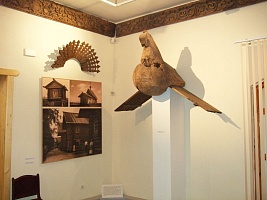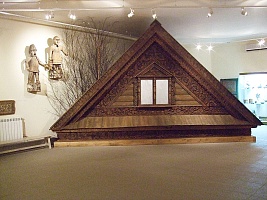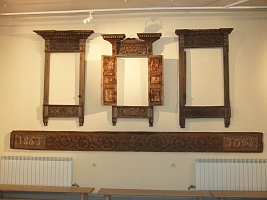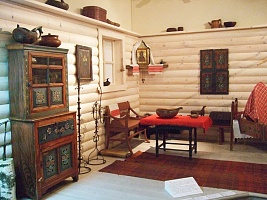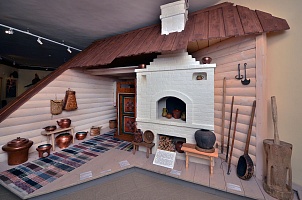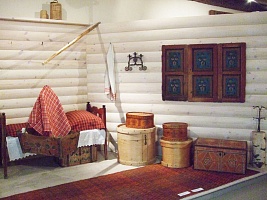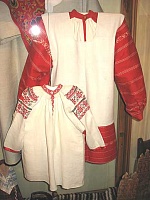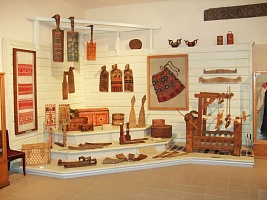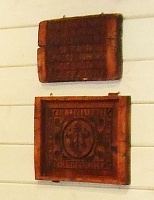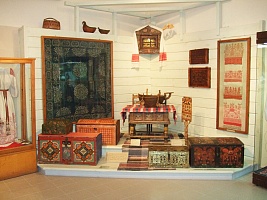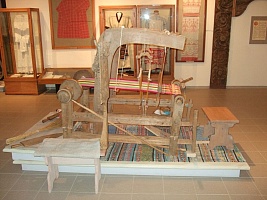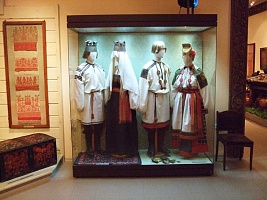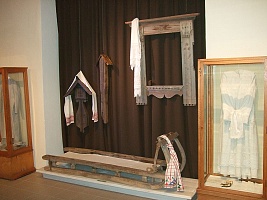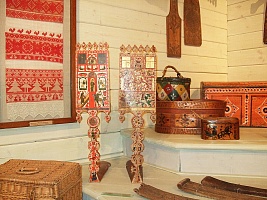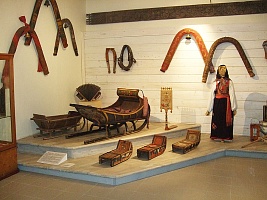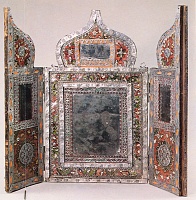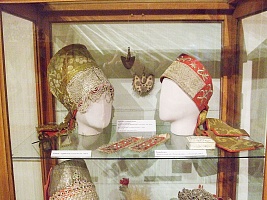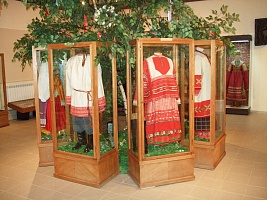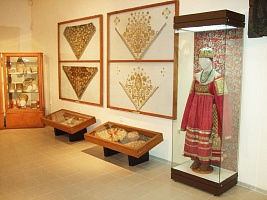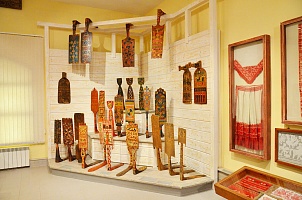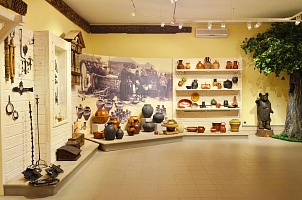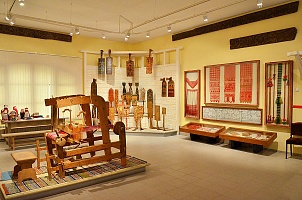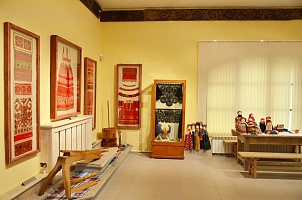Wednesday – Sunday 10 00 – 18.00
Ticket for 1 exhibition or exhibition:
- adult - 160 rubles.
- preferential - 80 rubles.
Photo and video shooting in the museum premises on the visitor's equipment (photo or video camera), without using a flash, tripod and monopod
- Photo - 170 rubles/person.
- Video - 230 rubles/person.
The World of a Russian Village
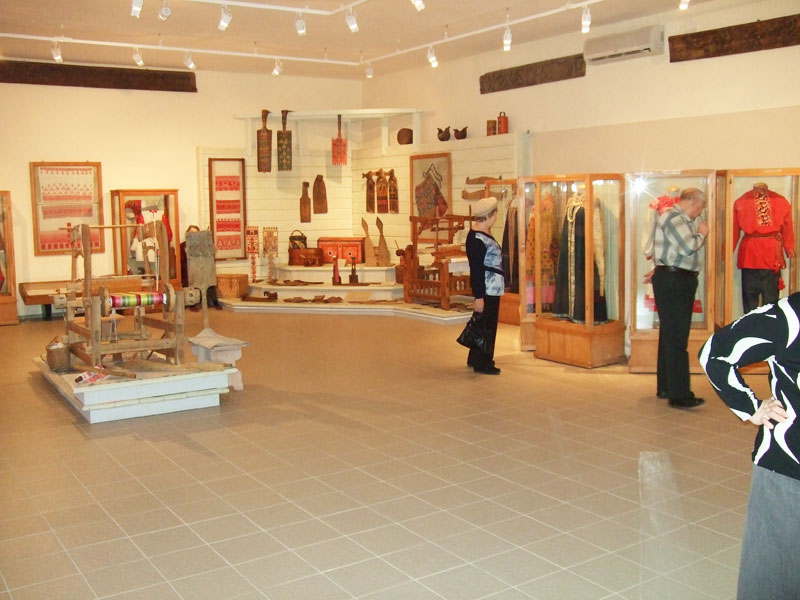
The recently opened exposition “The World of a Russian Village” presents one of the most comprehensive collections of Russian folk art of the 18th – early 20th century in Russia. The numerous specimens of traditional culture help visitors to imagine folk craftsmen’s way of life and to get acquainted with the most significant rituals; family, calendar and labor feasts of a Russian village.
The first hall
The first hall presents the exterior and interior decoration of a peasant house of the late 19th – early 20th century. The rich Museum collection of architectural carving shows various techniques, compositions and images in Northern Russia and in the Volga Area samples. The fronton, made in 1882 by Mikhail Malyshev from the Nizhegorodskaya Province, is most valuable. The free interpretation and superb technique characterize M. Malyshev as one of the most talented craftsman of the Volga house architecture.
The peasants’ belief in the “other world” is confirmed by the frequent kind and evil images: mermaids, mermen, seirens. Nearly the whole spectrum of the mythological images and motifs of the Volga architectural carving is represented in the window-frame of the late 19th century from the Nizhegorodskaya Province. It reflects our ancient ancestors’ ideas of the world.
The peasant house interior was determined by the tradition that passed from generation to generation. The late 19th – early 20th century interior of the Vyatka-Vologda Region is conventionally staged. Each corner of the heated part of the house had its significance and was used as a separate room. In contemporary terms, four corners corresponded to a kitchen, hall, sitting-room and bed-room. The main parts were stove and “red” corners of the house, presenting special sacral centers.
According to the northern Russian tradition “the Russian” stove was to the right or to the left of the entrance. Near the stove there usually was a passage with a barrel or a tub for water and a hand-washer with a towel. At the stove side was a painted plank structure which was connected with the stove. The interior was plain and laconic. The earliest pieces of furniture were benches and shelves made of wide beams framed into the wall.
The shelves were used for tableware and various utensils. The benches were used as seats. The benches with attached seats served as beds. The interior included portable items – tables, benches, baskets. In the second half of the 19th century, there spread chests, cupboards, chairs, beds, sofas that were originally used only in chambers. The bits of furniture were often cut, sculptured or lathed and decorated with multi-colored ornamental painting.
The second hall
The second hall presents the exhibits connected with maternity, christening party, wedding, burial and memorial rituals and traditions of a Russian village in the late 19th – early 20th century. The specimens of folk children clothing are rare in the museum collections. The group of baby and children clothes from the Kursk and Ryazan Provinces is very valuable. It includes baby-sheets, swaddling clouts, children blanket and head-pieces for baby-sheets embroidered in golden thread from Northern Russia.
As a rule, children in peasant families were not spoiled. Printed honey-cakes were the only dainty and desirable gifts for them. The cakes were made with the help of carved wooden blocks with recessed ornaments and flowers or figures of birds, fish and horses.
For little children the Museum organizes Sunday master-classes in making a traditional peasant rag doll. The professional artist combines the class with a detailed story about the doll, its history and sacral meaning echoed in folk tales.
The large part of the exhibition is dedicated to the wedding ritual. The new family was never a private affair. It was a ritual of social significance. Peasant children were prepared for the future family life from the earliest age. Girls of 7-8 learned to take part in preparation of their dowry that depended on the family welfare. The exposition reflects this theme in a certain group of meaningful items: distaffs, scutchers, smoothers, richly decorated with scenes of young people gathering and match-making from the Northern and Volga Areas; towels with ornamental childbirth symbols and chests containing dowry.
According to the old tradition, a girl made home-spun canvases for her wedding dress. The Museum visitors can see inter-active exhibits of the early 20th century from the Vyatka Province. They help to illustrate the process of canvas production. The scutcher was used to clean flax stems of the ruff cover. The distaff and spindle were used for spinning. The loom is still used by the experienced weaver demonstrating the production of multi-colored rugs.
Young people of marriage age took an active part in chat-in parties, round dances and games. The valuable collection of gala costumes is displayed like a round dance. It presents dresses of the 19th – early 20th century from the northern provinces of Russia and wedding costumes of the early 20th century from the Voronezh Province. The wedding costumes are distinguished by numerous articles, bright colors and rich ornamentation full of good-minded symbols.
Peasants preserved their wedding costumes carefully through the whole life. They were often used as burial clothes. There was a saying “to die in one’s wedding costume”. The ancient beliefs in “the other world” are illustrated by the items traditionally put in the coffin: a block of soap, comb, coins – so that the departed could use them there. A separate group of exhibits includes tomb crosses and towels bearing embroidered tomb crosses with blowing flowers at the ends, symbolizing beliefs in immortal soul..
The third hall
The third hall presents festive culture of a Russian village in the late 19th – early 20th century. The main traditional calendar feasts – the Nativity of Christ, Shrovetide, St. George Day, The Trinity – are illustrated by the exhibition complexes presenting bright festive attributes. The unique threefold mirror, shaped like an image-case, dates back to the 17th century. The mirror is associated with a popular tradition of Christmastime fortunetelling. Its main themes were wedding and family life.
The fine horse bows, shapely sled for gala rides, small sledges from the Vologda Province for the newly wedded couple’s tobogganing are attributes of the Shrovetide.
The Trinity was marked by the decoration of houses and churches with birch branches and ritual dances around birch trees. “The Trinity round dance” is conventionally staged by the gala female and male costumes of the South Russian Provinces. The costumes are decorative. They demonstrate aharmonious combination of various techniques and materials. Women and maiden head-dresses supplement the female costumes of the European areas of Russia.
Fairs, organized in towns and large villages, were important festive elements. There gathered people from the surrounding places. All famous handicraft centers sold their goods. Pottery was sold from the carts. The Museum displays a large group of traditional ceramic vessels of the 19th – 20th centuries. The vessels are different in function, technique and decoration.
The exhibition curators believe, that “The World of a Russian Village” brings us back to the sources of national culture, helps to perceive the optimistic folk world-view, intense way of life, understanding of beauty and kindness.
The fourth hall
The hall of the exposition is devoted a theme of labour activity of the peasants, traditional female and man's crafts, house employment. Acquaintance to them will help our contemporaries to realize more deeply the daily life of the Russian peasant, which filled with the big inner meaning.
In this hall has recreate traditional processes of manufacturing and fabric dressing, potter's, stuffed and forge workshops on an example of the big complexes of original exhibits 17th - the beginnings of the 20th centuries from the Central Russia and Russian North by the conditional-scenic form.
Visitors will get acquaint with unique exhibits - shod chests, wedding embroidered valance, pattern stuffed fabrics and carved boards (“manera”), which were used for the drawing press on a fabric, the big beehive in the form of a bear, carved and painted distaffs from different regions of Russia
The exposition will promote spiritual education of Russians, their junction to museum values, revival of interest to sources of national culture, in its complete kind.









